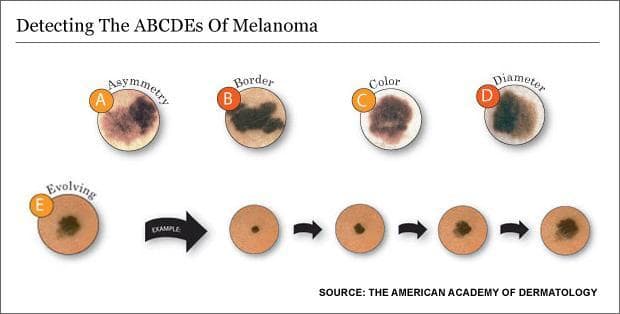Advertisement
A Cancer Visible To The Naked Eye, But Doctors Aren't Looking

Did you realize there's one type of cancer that's usually immediately visible to the naked eye?
It's skin cancer.
So it's important for doctors to recognize which type of moles might actually be deadly melanomas, and which ones are just plain moles.
But a new study (PDF) by researchers at Harvard and Boston University finds that most doctors-in-training say they don't have the skills necessary to perform a basic skin cancer exam.
There's a saying by an Australian surgeon that gets quoted a lot by skin cancer doctors: "Malignant melanoma writes its message in the skin with its own ink and it is there for all of us to see." In other words, if you have a cancerous mole, you can probably spot it with your own eyes, unlike other tumors.
That's why Alan Geller is so troubled by the results of a survey he helped conduct that asked medical residents about their training in skin cancer exams.
"We were very, very surprised," Geller recalls. "About three-quarters of them were never trained in the skin cancer exam, and more than half never once practiced the examination during their primary care residency."
Geller, who's a senior research scientist at the Harvard School of Public Health, says those high levels of inexperience are really worrisome. Many of those medical residents surveyed are going to become primary care doctors — and they should be able to identify a malignant melanoma when they see one.
If doctors don't have that skill set, "patients of high risk in the United States are in big-time trouble," Geller says.
Advertisement
So he says a head-to-toe skin cancer exam should be a basic part of every doctor's training. A full exam means the patient wears nothing but a gown while a doctor checks for unusual moles in every nook and cranny of their body, from their scalp to their feet.
"The good news is that among physicians who do look at the skin carefully — and it's not that many — they do tend to find earlier melanoma than when the patient detects it on their own," Geller notes.
And the earlier a melanoma is diagnosed, the more likely the patient's cancer can be cured.
But not every doctor thinks it makes sense to teach all medical residents to do full skin exams, especially considering how much else they have to learn.
Dr. Pieter Cohen helps run a residency program at Cambridge Hospital, which was one of the hospitals whose doctors-in-training were surveyed.
"It's important to keep in mind that just because we can screen for something doesn't necessarily mean that it will improve health," Pieter says, "and that we need to look carefully at the data to decide where we should spend our energy."
Cohen says there is no solid data showing that screening for skin cancer ultimately reduces death rates. He also says skin exams can lead to false positives that result in unnecessary biopsies.
And he says in the limited time doctors have to spend with their patients, they should do procedures that have been proven to reduce deaths, such as screening for colon cancer and cervical cancer.
"Now, I'm not saying that a complete skin exam is never appropriate," he adds. "So if someone's at risk — let's say they personally had a melanoma or they have a first-degree relative with a melanoma or they're fair skinned or have had significant sunburns when they were younger — then these people definitely deserve a complete skin exam."
Even though Cambridge Hospital doesn't teach all its medical residents to do full skin cancer exams, Cohen says it does train them to distinguish between a normal mole and a suspicious-looking one that might need to be biopsied.
But Harvard's Alan Geller says even if all patients don't need a full skin exam, their doctors should at least know how to do one.
"If we're talking about a three-minute examination where that mole can be identified at a really early point and taken out," Geller says, "then we've saved many, many lives through a very, very non-invasive procedure."
And that, he says, is well worth the time.
Geller also says that medical residents who are being taught to administer skin cancer exams should be trained to focus specifically on men's backs, and on the backs of women's legs, since many melanomas are found in those areas.
The study appears in the October issue of the "Archives of Dermatology".
This program aired on October 20, 2009.
